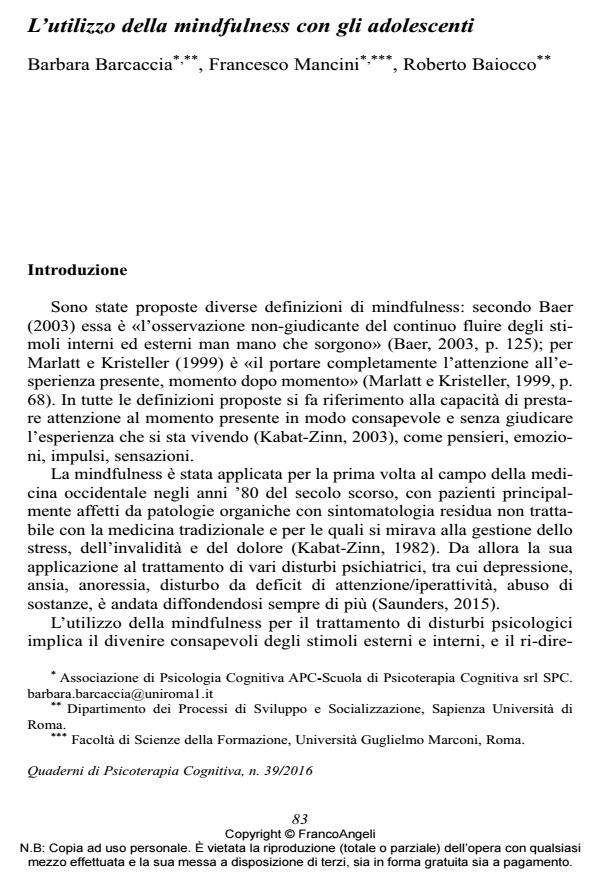L’utilizzo della mindfulness con gli adolescenti
Titolo Rivista QUADERNI DI PSICOTERAPIA COGNITIVA
Autori/Curatori Barbara Barcaccia, Francesco Mancini, Roberto Baiocco
Anno di pubblicazione 2016 Fascicolo 2016/39
Lingua Italiano Numero pagine 16 P. 83-98 Dimensione file 113 KB
DOI 10.3280/QPC2016-039006
Il DOI è il codice a barre della proprietà intellettuale: per saperne di più
clicca qui
Qui sotto puoi vedere in anteprima la prima pagina di questo articolo.
Se questo articolo ti interessa, lo puoi acquistare (e scaricare in formato pdf) seguendo le facili indicazioni per acquistare il download credit. Acquista Download Credits per scaricare questo Articolo in formato PDF

FrancoAngeli è membro della Publishers International Linking Association, Inc (PILA)associazione indipendente e non profit per facilitare (attraverso i servizi tecnologici implementati da CrossRef.org) l’accesso degli studiosi ai contenuti digitali nelle pubblicazioni professionali e scientifiche
Negli ultimi anni l’utilizzo della mindfulness per il trattamento di problemi psicologici in eta evolutiva e andato significativamente incrementando: sia nei disturbi esternalizzanti che nei disturbi internalizzanti puo essere effettivamente utile addestrare i ragazzi a lasciar andare i propri contenuti mentali, siano essi pensieri depressivi, ansiosi, o aggressivi, una volta che sono comparsi alla mente. In particolare la disposizione mindful e correlata con livelli piu bassi di psicopatologia in adolescenza rispetto ai ragazzi che presentano un’alta mindfulness di tratto. Inoltre, vi sono diversi dati incoraggianti per il trattamento di alcuni disturbi mentali anche per questa fascia d’eta. Ciononostante, gli studi finora disponibili rivelano la necessita di adottare metodologie piu rigorose, cosi come l’incremento del numero degli studi, per migliorare la valutazione dell’uso della mindfulness in adolescenza. Per quanto riguarda l’adattamento delle pratiche agli adolescenti, e utile proporre loro una varieta di pratiche diverse, per evitare noia e disimpegno, oltre a porre attenzione all’utilizzo di esercizi "su misura", come l’uso dello smartphone consapevole, o l’ascolto mindful di brani musicali. Anche la durata dei vari esercizi va adattata, riducendo considerevolmente la lunghezza delle pratiche a circa dieci minuti, a seconda della pratica considerata. L’acquisizione di capacita di mindfulness sembra essere una competenza centrale per gli adolescenti, al fine di gestire meglio l’impulsivita, modulare le emozioni, ridurre l’oppositivita a emozioni negative indesiderate, incrementarne l’accettazione, cosi come la capacita di provare emozioni positive. Le pratiche di mindfulness potrebbero costituire un elemento innovativo ed efficace per la gestione e riduzione di sintomatologia esternalizzante e internalizzante in adolescenza.
Parole chiave:Mindfulness, adolescenti, adattamento delle pratiche
Barbara Barcaccia, Francesco Mancini, Roberto Baiocco, L’utilizzo della mindfulness con gli adolescenti in "QUADERNI DI PSICOTERAPIA COGNITIVA" 39/2016, pp 83-98, DOI: 10.3280/QPC2016-039006